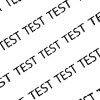I am quite impressed with the help I got for my last post. Way to go Gurus! Let me try something harder:
Filter > Distort > Displace is undervalued gem, yet it has significant drawback - the displacement does not interpolate between adjustment pixels. This shortcoming in combination with the fact that Photoshop uses very fine noise to smooth transitions between gradations in 8-bit channels and therefore creates very unsightly, jugged effect even when displacement source is a gradient. Unfortunately the filter does not work with 16-bit channels and its closest relative - Liquify uses meshes instead of images for input.
So here is my question: does any of you aware of a way, in Photoshop or otherwise to create silky smooth displacements within 2D imagery (there are bunch of software to accomplish it in 3D) using interpolated 8 bit or original 16-bit (or higher) images as source?
The attached image was produced by displacing perfectly smooth word "test" with plain black to white gradient at 999% displacement strength.

Filter > Distort > Displace is undervalued gem, yet it has significant drawback - the displacement does not interpolate between adjustment pixels. This shortcoming in combination with the fact that Photoshop uses very fine noise to smooth transitions between gradations in 8-bit channels and therefore creates very unsightly, jugged effect even when displacement source is a gradient. Unfortunately the filter does not work with 16-bit channels and its closest relative - Liquify uses meshes instead of images for input.
So here is my question: does any of you aware of a way, in Photoshop or otherwise to create silky smooth displacements within 2D imagery (there are bunch of software to accomplish it in 3D) using interpolated 8 bit or original 16-bit (or higher) images as source?
The attached image was produced by displacing perfectly smooth word "test" with plain black to white gradient at 999% displacement strength.



 Looks good, but for Displacement filter it's not good at all.
Looks good, but for Displacement filter it's not good at all.